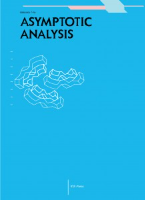
ASYMPTOTIC ANALYSIS
Scope & Guideline
Exploring the Depths of Asymptotic Methods in Mathematics
Introduction
Aims and Scopes
- Asymptotic Analysis of Differential Equations:
The journal emphasizes rigorous asymptotic analysis of solutions to various differential equations, particularly focusing on PDEs, and their long-time behavior. - Existence and Regularity of Solutions:
Research often delves into existence results and regularity properties for solutions of nonlinear and singular differential equations, providing foundational insights into their behavior. - Homogenization and Multiscale Analysis:
A significant focus lies in the homogenization theory, which studies the behavior of PDEs in complex or heterogeneous media, often leading to simplified models that capture essential features. - Stability and Control Theory:
The journal publishes studies on stability analysis of dynamical systems, including control problems, which are crucial for understanding the robustness of solutions in applied contexts. - Nonlinear Dynamics and Reaction-Diffusion Systems:
Research includes nonlinear phenomena and reaction-diffusion systems, exploring their asymptotic behavior and critical phenomena in various applications. - Spectral Analysis and Eigenvalue Problems:
The journal features work on spectral theory, particularly concerning elliptic operators and eigenvalue problems, which are fundamental in understanding the qualitative behavior of solutions.
Trending and Emerging
- Nonlocal and Fractional Differential Equations:
There is a growing interest in nonlocal and fractional differential equations, reflecting their relevance in modeling phenomena across various disciplines, including physics and biology. - Stochastic and Random Perturbation Methods:
Recent publications indicate a trend towards incorporating stochastic elements into asymptotic analysis, addressing uncertainties in mathematical models and their implications. - Complex Systems and Network Dynamics:
Research on complex systems, particularly in the context of network dynamics and interactions, has gained traction, showcasing the interdisciplinary nature of current mathematical inquiries. - Multiscale and Homogenization Techniques:
The application of multiscale analysis and homogenization techniques continues to rise, particularly in the study of materials and phenomena exhibiting varying scales. - Advanced Numerical Methods and Simulations:
There is an increasing emphasis on the development and application of advanced numerical methods for solving complex asymptotic problems, indicating a blending of analytical and computational approaches.
Declining or Waning
- Low-dimensional Dynamical Systems:
Research on low-dimensional dynamical systems seems to be waning, possibly due to a shift towards more complex systems with higher dimensionality and richer dynamics. - Classical Perturbation Methods:
Classical perturbation techniques, once a staple in asymptotic analysis, are less frequently employed as researchers increasingly adopt modern numerical and analytical methods. - Basic Linear PDEs:
There is a noticeable decrease in studies focusing on basic linear PDEs, indicating that researchers may be more interested in complex nonlinear problems or those with additional constraints. - Elementary Asymptotic Expansions:
The frequency of papers discussing elementary asymptotic expansions has diminished, suggesting a trend towards more sophisticated asymptotic techniques and applications. - Static Models without Time Dynamics:
Research focusing on static models without consideration of time dynamics has become less prevalent, as the community emphasizes dynamic and time-dependent problems.
Similar Journals

Opuscula Mathematica
Championing Accessibility in Mathematical ResearchOpuscula Mathematica is an esteemed open-access journal published by AGH University of Science & Technology Press in Poland, specializing in the field of mathematics. Since its inception, it has provided a collaborative platform for researchers and scholars to share innovative mathematical insights and solutions, expanding its reach globally. With an impressive Q2 ranking in the realm of miscellaneous mathematics for 2023 and a notable Scopus ranking of Rank #139/399, it stands as a significant conduit for researchers seeking to publish high-quality, peer-reviewed articles. The journal has embraced open-access principles since 2004, ensuring that advancements in mathematical research are accessible to all. By publishing original research, reviews, and scholarly notes, Opuscula Mathematica plays a pivotal role in enhancing the visibility of vital mathematical discoveries and fostering academic discourse. Its convergence years from 2012 to 2024 highlight the journal's commitment to ongoing relevance and evolution in a dynamic research landscape.

Analysis & PDE
Advancing the Frontiers of Analysis and PDE.Analysis & PDE is a premier journal dedicated to advancing the fields of analysis and partial differential equations, published by Mathematical Science Publications. With its ISSN 1948-206X, this journal has established itself as a critical platform for the dissemination of high-quality research since its inception in 2008. An indicator of its scholarly impact, it holds a prestigious Q1 ranking in the 2023 categories of Analysis, Applied Mathematics, and Numerical Analysis. The journal's esteemed standing is further underscored by its impressive Scopus rankings, including Rank #24 in Mathematics Analysis, placing it in the 87th percentile of its category. Aimed at researchers, professionals, and advanced students, Analysis & PDE provides a vital forum for innovative studies that push the boundaries of mathematics while fostering a deeper understanding of analytical methods and their applications across various real-world challenges. With no open access restrictions, it remains an accessible resource for the global research community. For more information, please reach out to the editorial office at the Department of Mathematics, University of California, Berkeley.
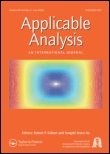
APPLICABLE ANALYSIS
Shaping modern mathematics through rigorous research.APPLICABLE ANALYSIS, published by Taylor & Francis Ltd, is an esteemed journal dedicated to advancing research in the fields of analysis and applied mathematics. With its ISSN 0003-6811 and E-ISSN 1563-504X, the journal has been a cornerstone of scholarly communication since its inception in 1971, with a convergence of content projected until 2024. Belonging to the Q2 category for both Analysis and Applied Mathematics as of 2023, it ranks impressively at #58 out of 193 in the field of Mathematics Analysis and #274 out of 635 in Mathematics Applied Mathematics as per Scopus metrics. Although the journal currently does not offer Open Access, it continues to provide valuable insights and cutting-edge research that is vital for academics, professionals, and students who seek to deepen their understanding and application of analytical techniques in various contexts. Its commitment to high-quality research plays a significant role in shaping the landscape of modern mathematics.
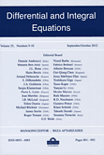
Differential and Integral Equations
Unraveling Complex Equations for Scientific ProgressDifferential and Integral Equations is a renowned peer-reviewed journal published by KHAYYAM PUBL CO INC, focusing on the rich and expanding field of mathematical analysis and applied mathematics. With its ISSN 0893-4983, this journal serves as a critical platform for disseminating innovative research, particularly in the areas of differential and integral equation theory and its applications across various scientific disciplines. Maintaining a significant presence in the academic community, it ranks in the Q2 category for both Analysis and Applied Mathematics as of 2023, highlighting its impact and relevance. The journal's indexed rankings place it at the 67th percentile in Mathematics - Analysis and the 54th percentile in Mathematics - Applied Mathematics, further establishing it as a valued resource for emerging researchers and established professionals alike. Although open access is not currently available, the journal remains crucial for those seeking to contribute to and stay informed on advancements in differential equations and their applications, with converged publication years from 1988 to 1995, 2009 to 2014, and continuing through 2016 to 2024. Researchers, professionals, and students will find that this journal provides essential insights and fosters collaboration within the dynamic mathematical community.

ANNALI DI MATEMATICA PURA ED APPLICATA
Advancing Knowledge Through Rigorous ResearchANNALI DI MATEMATICA PURA ED APPLICATA is a prestigious journal published by Springer Heidelberg, focusing on the field of Applied Mathematics. With a rich history dating back to its initial publication stages from 1858, this journal continues to serve as a vital platform for researchers and professionals seeking to disseminate high-quality, peer-reviewed research. The journal's strong reputation is reflected in its Q1 ranking in Applied Mathematics and its Scopus rank of #335 out of 635, placing it in the 47th percentile, showcasing its impact in the field. Although it is not an open-access journal, it provides exclusive insights and advancements in mathematical applications, allowing academics to explore innovative methodologies and theoretical developments. The combination of its long-standing tradition and contemporary relevance makes ANNALI DI MATEMATICA PURA ED APPLICATA an essential resource for scholars and students looking to deepen their understanding of mathematics and its practical applications.

NONLINEAR ANALYSIS-THEORY METHODS & APPLICATIONS
Fostering Excellence in Nonlinear Research and ApplicationNONLINEAR ANALYSIS-THEORY METHODS & APPLICATIONS, published by PERGAMON-ELSEVIER SCIENCE LTD in the United Kingdom, is a premier journal that has been advancing the field of nonlinear analysis since its inception in 1976. This esteemed journal has a commendable impact factor, reflecting its crucial role in disseminating high-quality research in Analysis and Applied Mathematics, having achieved Q1 rankings in both categories for 2023. With an impressive Scopus ranking of #36 out of 193 in Mathematics-Analysis and #194 out of 635 in Mathematics-Applied Mathematics, it provides a platform for groundbreaking studies that push the boundaries of theoretical and applied methodologies. Although it operates through a subscription model, the journal’s comprehensive content serves as an invaluable resource for researchers, professionals, and students alike, contributing to the ongoing dialogue in the field and fostering advancements in technology and science.
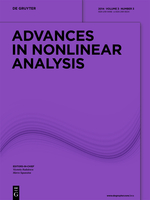
Advances in Nonlinear Analysis
Pioneering Insights in Nonlinear MathematicsAdvances in Nonlinear Analysis is a highly regarded academic journal dedicated to the exploration and dissemination of research in the field of nonlinear analysis. Published by DE GRUYTER POLAND SP Z O O, this journal has established itself as a pivotal resource for scholars and practitioners, achieving an impressive Q1 ranking in the Mathematics - Analysis category, and placing in the top 97th percentile within its discipline as per the latest Scopus rankings. With an Open Access model since 2018, Advances in Nonlinear Analysis ensures that cutting-edge research is readily accessible to a global audience, promoting the advancement of knowledge without barriers. Covering a broad spectrum of topics within nonlinear analysis, this journal invites contributions that involve either theoretical or applied aspects, making it an essential platform for exchanging innovative ideas and results in this dynamic field. Researchers, professionals, and students alike will find this journal invaluable for staying abreast of the latest developments and methodologies in nonlinear analysis.
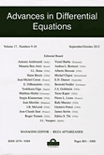
Advances in Differential Equations
Charting New Territories in Differential Equation TheoryAdvances in Differential Equations is a premier journal that serves as a vital resource for researchers, professionals, and students in the fields of mathematics, particularly focusing on the theory and application of differential equations. Published by KHAYYAM PUBL CO INC, this journal has established itself as a key player in the academic landscape since its inception in 1996, with continuous contributions that bridge theoretical math and practical applications. With an impressive impact factor reflected in its category quartiles—ranking Q1 in Analysis and Q2 in Applied Mathematics for 2023—this journal is recognized for the quality and rigor of its published works. The journal's scope encompasses a wide array of topics, encouraging authors to submit innovative research that can advance the understanding of differential equations in various contexts. Although it does not operate as an Open Access journal, the subscription model ensures that readers receive high-quality, peer-reviewed research that contributes significantly to ongoing developments in mathematics. Based in the United States, Advances in Differential Equations continues to publish articles until 2024 and remains a crucial outlet for interdisciplinary collaboration and discourse in the mathematical sciences.
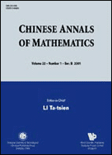
CHINESE ANNALS OF MATHEMATICS SERIES B
Illuminating the Path of Mathematical Discovery Since 1980CHINESE ANNALS OF MATHEMATICS SERIES B, published by Shanghai Scientific Technology Literature Publishing House, is a prominent journal dedicated to fostering research and development in the field of mathematics. With an ISSN of 0252-9599 and an E-ISSN of 1860-6261, this journal provides a platform for the dissemination of innovative mathematical theories and methodologies. As of 2023, it is categorized within the Q4 quartile in *Applied Mathematics* and has achieved a commendable Q3 rank in *Mathematics (miscellaneous)*, emphasizing its growing influence in academia. Despite not being an open-access publication, it serves as a valuable resource for researchers, professionals, and students seeking to explore diverse mathematical topics, particularly from a unique regional perspective. The journal's extensive publication history—from 1980 and continuing to 2024—demonstrates a longstanding commitment to advancing mathematical knowledge and providing insights into various disciplines related to mathematics.

JOURNAL OF EVOLUTION EQUATIONS
Charting new territories in the study of evolution equations.Welcome to the JOURNAL OF EVOLUTION EQUATIONS, a leading academic journal published by SPRINGER BASEL AG, dedicated to the field of mathematics, with a specific emphasis on the analysis of evolution equations. Since its inception in 2001, this journal has become a central platform for researchers and professionals to disseminate innovative findings and theoretical advancements in the domain. With a commendable Q1 ranking in the category of Mathematics (miscellaneous) and a Scopus position of Rank #24/90, it reflects the esteemed quality and impact of the research it publishes. The journal aims to foster scholarly communication by covering all aspects of evolution equations, including their applications to various fields. While currently not available as an open-access publication, it offers access through various academic institutions, ensuring that high-quality research remains accessible to the scientific community. As it approaches its converged years of publication up to 2024, JOURNAL OF EVOLUTION EQUATIONS continues to be an invaluable resource for anyone seeking to expand their knowledge and understanding in this critical area of mathematical study.